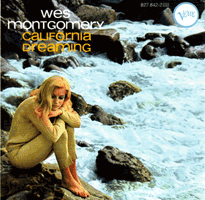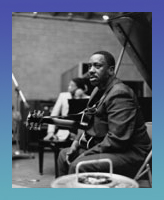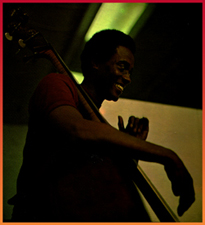

|
Soundclip:
|
| See Steve's Hand-Written Solo
Transcription |
|
Wes Montgomery's solo on:  The latter is, by the way, the longest track on the entire recording at 6-minutes. None of the others are longer than 4-minutes and most hover around the 3-minute mark. Not a good sign for those of us who wanted to hear Wes play. To see such "Pop" titles as, the title track, and "Sunny" was equally disheartening. However, it was wonderful to see him play one of Jimmy Van Heusen's most beautiful ballads "Oh, You Crazy Moon" and the great Latin bolero, "Tres Palabras" which appears on this recording as "Without You." The Latin element is important to the feel of many the tunes interpreted here. "Sundown" however is a classic Wes Montgomery blues, but in A-natural. Yes, a "guitar key" but, in truth, perhaps out of respect of pianists, in a Jazz context, one rarely sees a blues in this key. For this presentation, we are only taking a look at Wes' first 2 choruses of single-note lines. On the recording, he follows these choruses with 2 in octaves, and 1 in chords. The latter is, by the way, the longest track on the entire recording at 6-minutes. None of the others are longer than 4-minutes and most hover around the 3-minute mark. Not a good sign for those of us who wanted to hear Wes play. To see such "Pop" titles as, the title track, and "Sunny" was equally disheartening. However, it was wonderful to see him play one of Jimmy Van Heusen's most beautiful ballads "Oh, You Crazy Moon" and the great Latin bolero, "Tres Palabras" which appears on this recording as "Without You." The Latin element is important to the feel of many the tunes interpreted here. "Sundown" however is a classic Wes Montgomery blues, but in A-natural. Yes, a "guitar key" but, in truth, perhaps out of respect of pianists, in a Jazz context, one rarely sees a blues in this key. For this presentation, we are only taking a look at Wes' first 2 choruses of single-note lines. On the recording, he follows these choruses with 2 in octaves, and 1 in chords.On yet another familiar sounding Creed Taylor production, Wes finds himself in the rhythm section company of pianist Herbie Hancock; bassist Richard Davis; drummer Grady Tate, and conguero Ray Barretto, all with brass and woodwind orchestrations by the wonderful, Don Sebesky. After Wes' 5 choruses, Herbie follows with 5 of his own, and, of course, they are particularly great while staying in context. Let's face it, these productions were not exactly as loose as the Blue Note sessions of this general time period. This transcription was originally done around the time of the release, or shortly thereafter. But, the true inspiration came from my dear childhood friend, Dan Keller, who was never a professional musician, though he was an accomplished classical pianist. It should be pointed out that he was playing the guitar long before I ever even thought of trying to play. We both attended U.C.L.A. together, and went to see many concerts together as well, including seeing Wes Montgomery several times. After "CALIFORNIA DREAMING" had been released, one day, Dan came over for a visit, and he promptly sat down and played along with the 1st chorus of Wes' solo. Yes, note for note. But, what caught my attention, more than anything else was just how accurately Dan heard and executed the passage between bars 3-4. And, in the end, that alone served as my inspiration to follow through on it, and to transcribe the entire single-note portion of the solo. It was also a serious slap in the face me, a "wake-up call" if you will, that I had to improve my capacity to hear what was being played by all the great Jazz artists of that time. Dan demonstrated to me, without saying a word, that I had a long ways to go! Chorus [1] begins with a simple blues phrase, and that phrase is given a chordal punctuation on the and-of-2. The voicing played is a very traditional A7(13) chord with the root, A-natural, on top. This is followed in bar 2 with a blues phrase, and a corresponding chordal punctuation on the IV7 chord, D7(9). Musically, and logically, the top voice remains that same A-natural on the E-string at the 5th fret. In bar 3, as the progression returns to the I7 chord, there is another blues phrase, but this time, the punctuation is a more simple 2-note "guide tone" voicing(G-C#), played on one's D and G-strings. The guide tones give one the 'guts' of the chordal sonority, without overdoing it. It should also be noted that these basic punctuations, and this style, mirror the way Wes Montgomery stated his own 'head' to the tune. For what it's worth, this simple blues head is offered in my book, "The WES MONTGOMERY GUITAR FOLIO"(Gopam). Like all of Wes' blues heads, "Sundown" offers the same wonderful balance between blues lines and interesting chordal punctuations.  And now, we have arrived at the one passage which served as the motivation for doing this little transcription. It is a series of 8th-note triplets which begin just before beat 4 of bar 3. Over the course of the many analysis pages offered here at Korner 1, we have had discussions about the way various players treat bar 4 of a blues. In this one little passage, Wes chooses to employ, depending upon how you want to interpret the notes, a sense of A7(9sus) or Em7(9sus)/A. As we say here in the U.S.: "Six of one, half a dozen of the other!" Which translates to: They are, in essence, the same! Logic would indicate, based upon where he must have played the guide tones(G-C#) just prior to this, that the first F# had to have been played on the D-string at the 4th fret. If I was going to help you to break down the fingering of this particular line, I would ask you to consider thinking of it in two distinct pieces. The first piece of the line goes up until the E-natural in the middle of beat 2 of bar 4. The E-natural appears at the 5th fret on your B-string. It is my sense that, from there, Wes vaults to that G-natural at the 12th fret on his G-string, and finishes the phrase with, what I would refer to as, an Em7(9) arpeggio. After the line peaks at the high F# in bar 5 as the D7 chord arrives, the triplets continue and descend in what is, essentially, D minor pentatonic. But here, you should consider this as merely a 'step-brother' to the D blues scale, just minus the appearance of an Ab(G#). If you practice, and slow-ly, at putting these two pieces of the same line together, eventually, you can develop the same grace and easy-flow that Wes Montgomery had. Keep in mind that he had probably played lines like this, perhaps even the same one, on countless occasions during all those nights, with 2 gigs per night, during his formative years in Indianapolis. This is why a passage like this, for Wes, sounded so effortless. But, you can do it too!!! Bars 6-7 offer more blues-based material. It would probably serve you well to notice that Wes almost never plays a C#, the major 3rd of A7, without playing a grace-note C-natural before it. In my day, musicians used to refer to this as putting a bit of "grease" on the note. To just strike a C#, the 3rd of the chord, will always sound much too "vanilla" to most players, and to listeners alike.  Rock and Blues players accomplish the same thing by simple bending-up from the C-natural about a quarter-tone. For most guitar purists, this is the more soulful way to do it, and, in a sense, it is the most guitaristic way! You dig? At the end of bar 7, Wes throws in a nice C#m7 chord. Again, this mirrors the way the head is stated. Wes treats this ii-V of C#m7-F#7 with a C#m7 arpeggio leading to an A#, which is a key chord-defining tone for the F#7 chord. From there, considering that there are only two choruses of single-note lines, Wes employs the only altered tone, that being the b9, a G-natural, in a traditional descending passage which leads to a D-natural, the m3rd of Bm7 in bar 9. In bars 9-10, Wes treats this ii-V, Bm7-E7, in very much the same way as he treated the ii-V in bar 4. To repeat, he gives it a much more majestic and open sounding 'suspended' feeling. In other words, he plays through it without using any alterations to create tension towards a resolution. There is absolutely nothing wrong with this, not at all. It is, in the end, very beautiful. In a more pure 'blues' context, some might say that this linear approach is too "jazzy" for their taste. So, if you were to employ such lines in that context, be prepared for this kind of feedback!!! If you are looking for Wes' usage of altered tones, during the octave portion of his solo, you will hear the insertion of more alterations, here and there. And, during Chorus [5], the chord solo, there is one remarkable passsage at about the 2:37 mark that still sets my head to spinning! It appears in bar 8 of that chorus. Good luck! Rock and Blues players accomplish the same thing by simple bending-up from the C-natural about a quarter-tone. For most guitar purists, this is the more soulful way to do it, and, in a sense, it is the most guitaristic way! You dig? At the end of bar 7, Wes throws in a nice C#m7 chord. Again, this mirrors the way the head is stated. Wes treats this ii-V of C#m7-F#7 with a C#m7 arpeggio leading to an A#, which is a key chord-defining tone for the F#7 chord. From there, considering that there are only two choruses of single-note lines, Wes employs the only altered tone, that being the b9, a G-natural, in a traditional descending passage which leads to a D-natural, the m3rd of Bm7 in bar 9. In bars 9-10, Wes treats this ii-V, Bm7-E7, in very much the same way as he treated the ii-V in bar 4. To repeat, he gives it a much more majestic and open sounding 'suspended' feeling. In other words, he plays through it without using any alterations to create tension towards a resolution. There is absolutely nothing wrong with this, not at all. It is, in the end, very beautiful. In a more pure 'blues' context, some might say that this linear approach is too "jazzy" for their taste. So, if you were to employ such lines in that context, be prepared for this kind of feedback!!! If you are looking for Wes' usage of altered tones, during the octave portion of his solo, you will hear the insertion of more alterations, here and there. And, during Chorus [5], the chord solo, there is one remarkable passsage at about the 2:37 mark that still sets my head to spinning! It appears in bar 8 of that chorus. Good luck!What begins as a pick-up into Chorus [2], and continues through the first 2 bars of it, was almost enough to make me stop transcribing right there!!! Sometimes, someone plays a figure, and you can tell that, to write it out is going to challenge your perceptions and conceptions of rhythm. This was such a case. And, as you can see, it was, without question, very annoying to write out. And, it's possible that another transcriber might have written out the same passage in an alternate manner. But, rhythmic considerations aside, in essence, Wes is simply concentrating on the root and 5th(in two registers). Any good blues player might well have placed emphasis on those notes. As Wes moves into this chorus' bar 4, he again uses a G major arpeggio, which supplies the 7th, 9th, and 11th over the A7 chord. Again, to some, these are sounds that are 'too pretty' for the blues. But not for the Jazz musician, not at all. Wes moves through bar 4 without any altered tones to pass to the D7 chord in bar 5. It is also worth noting that, in bar 8 where the change is an F#7(a V7 of ii), Wes does not play an A#(the 3rd), which would be the fairly traditional thing to do. Again, in bars 9-10, the Bm7-E7, he concentrates on the pretty tones, relative to the Bm7 chord: C#(9th) and E(11th/sus), and over the E7, he already using a blues-oriented A7 type of figure. A musician I used to know once said to me: "When in doubt, play out!" Perhaps not such great advice!!! Perhaps, better advice might be, "When in doubt, play the blues!"  As always, I sincerely hope that you have enjoyed this rather brief 2 chorus Wes Montgomery solo. Writing an analysis, whatever the length might be, is always cause for afterthoughts about different aspects. In looking at the solo, especially as it appears on music paper, I find myself asking, "Why so many triplet groupings?" The tune is played at a tempo which I like to refer to as a "medium bounce." It's not quite slow enough to be a slow blues, and hardly fast enough to be something else. It just seems to fall into a tempo slot where triplets just 'feel good' to Wes, and hence, there they are. If you happen to have this track on your CD version, or on a compilation, I encourage you to take a listen to the full solo, and even to Herbie Hancock's solo for contrast. For example, in Chorus [3] of Herbie's solo, there's a fantastic passage during bars 3-4 at the 3:40 mark. And during Chorus [4], which is rich with motivic development, there is yet another nice little moment in bar 4 which occurs at about 4:05.
As always, I sincerely hope that you have enjoyed this rather brief 2 chorus Wes Montgomery solo. Writing an analysis, whatever the length might be, is always cause for afterthoughts about different aspects. In looking at the solo, especially as it appears on music paper, I find myself asking, "Why so many triplet groupings?" The tune is played at a tempo which I like to refer to as a "medium bounce." It's not quite slow enough to be a slow blues, and hardly fast enough to be something else. It just seems to fall into a tempo slot where triplets just 'feel good' to Wes, and hence, there they are. If you happen to have this track on your CD version, or on a compilation, I encourage you to take a listen to the full solo, and even to Herbie Hancock's solo for contrast. For example, in Chorus [3] of Herbie's solo, there's a fantastic passage during bars 3-4 at the 3:40 mark. And during Chorus [4], which is rich with motivic development, there is yet another nice little moment in bar 4 which occurs at about 4:05.Though I know that this is not related to sharing musical information with you all, I feel compelled to let you know that my dear friend of some 40+ years, Dan Keller, passed away several years ago from lung cancer. It was just before that he had tried, and successfully so, to quit smoking. But, considering that he started as a teenager, the effects were much too far gone to reverse. Perhaps to many, this is a familiar story, but, for those of us who loved and cared about Dan, it remains a great tragedy. So, I am simply urging anyone who might be reading this that, if you are still a smoker, please, please, PLEASE do everything in your power to stop right now!!! It is going to kill you!!! Yes, I know how easy it is to say that all those horrible diseases are only going to happen to others and not to you. But, is it worth to take the risk? Is it really worth it?!?!? I don't think so!
[Photos: Wes Montgomery w/ Herbie Hancock in the backgrouund
Richard Davis and Don Sebesky Photos by: Chuck Stewart] |